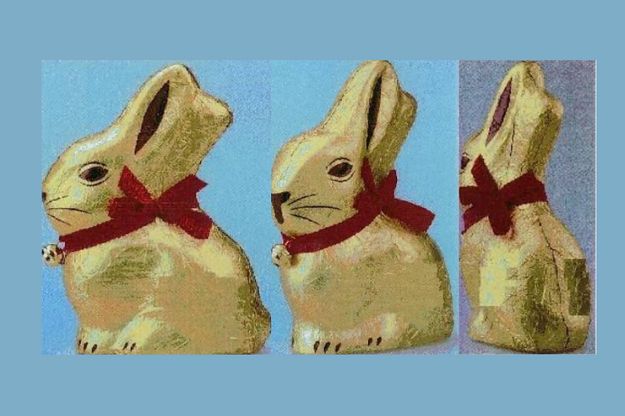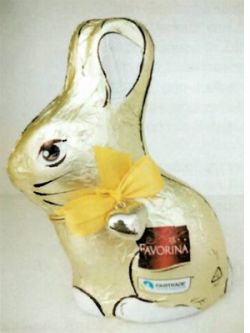The Facts
Lindt & Sprüngli AG, (Lindt) manufactures and sells food and luxury goods, in particular chocolate items. Lindt owns two Swiss trademark registration for a three-dimensional trademark for the goods "chocolate, chocolate goods, chocolate figures" in class 30. The sign looks like this with the colour claim

The other registration is in black and white. Lindt has sold a chocolate bunny wrapped in gold-coloured foil (Lindt bunny) since 1952 with practically the same shape and features.
Lidl Schweiz AG and Lidl Schweiz DL AG (collectively Lidl) have sold chocolate bunnies since 2017 (Lidl bunnies) in Switzerland. The Lidl bunny is shown below

The Action
In December 2018 Lindt brought an action for trademark infringement against Lidl concerning the sale of the Lidl bunnies. The action was dismissed on the basis that the Lidl bunnies sold by the defendants would not be confused with the plaintiff's trademark-protected signs. The Judge said the Lindt registrations were not distinctive because of the large number of chocolate bunnies in the marketplace.
The Appeal
Lindt appealed this decision to a panel of three Judges of the Swiss Federal Supreme Court. Lindt & Sprüngli AG v. Lindt & Sprüngli AG, August 30, 2022 The Panel said the two Lindt signs, whether with or without a colour claim - are recognized and understood as trademarks by purchasers of chocolate goods. It is notorious that the two signs not only have a high market presence and are well known but are also understood by a significant part of the public as indications of origin. That buyers primarily see the design of the goods in a form of the good changes nothing. Here, the forms were registered due to their long-standing use as a trademark and are perceived as a mark. The public attributes the signs to Lindt throughout Switzerland.
While the respective marks differ in several details, the overall impression they leave in the memory of a consumer is decisive for the confusion in trademark law. Not every design detail sticks in the memory of the average buyer, but the big features of the rabbit do: essentially a stylized, compact rabbit sitting on all four paws with a ribbon and pendant, a rather stern look and simple facial markings, wide slightly slanting protruding ears and smooth, curved surfaces. Buyers will also remember the golden colour. Overall, the rabbits are similar, and a risk of confusion exists.
The appeal was allowed. Lidl was prohibited from continuing to sell its bunnies. Lidl also unsuccessfully argued that ordering destruction of its Lidl bunnies was disproportionate, but the court disagreed. However, the Court noted that destruction of the Lidl bunnies did not necessarily mean that the physical substance of the characters (i.e. the chocolate) was to be destroyed.
The Canadian Position
Trademarks Act
In Canada it is also possible to obtain similar trademark protection. If the trademark consists exclusively or primarily of the three-dimensional shape of the goods specified in the application, or of an integral part or the packaging of the goods, an applicant must furnish the Registrar with any evidence that the Registrar may require establishing that the trademark is distinctive at the filing date of the application for its registration. The Registrar must, having regard to the evidence adduced, restrict the registration to the goods in association with which, and to the defined territorial area in Canada in which, the trademark is distinctive. Since there is a requirement to show that a trademark is distinctive it is only possible to secure a registration based on use. In practice this will mean that considerable time and effort will be given to locating evidence on a regional basis and preparing affidavits.
There are further limitations concerning this type of mark. First, a mark is not registrable if, in relation to the goods in association with which it is used, its features are dictated primarily by a utilitarian function. Second, a registration may be expunged by the Federal Court on the application of any person interested if the registration is likely to unreasonably limit the development of any art or industry. Finally, the registration does not prevent a person from using any utilitarian feature embodied in the trademark.
Industrial Design Act
Product shape or appearance may be protected under this Act. A "design" means features of shape, configuration, pattern or ornament and any combination of those features that, in a finished article, appeal to and are judged solely by the eye. The definition is qualified in that no protection extends to:
- features applied to a useful article that are dictated solely by a utilitarian function of the article; or
- any method or principle of manufacture or construction.
To be registered a design must be novel. The design, or a design not differing substantially from it, applied to a finished article that is the same as or analogous to the finished article regarding which the design is to be registered, must not been disclosed by the applicant, more than 12 months before the priority date of the design in the application, in such a manner it became available to the public in Canada or elsewhere. Similar considerations apply to other disclosures and disclosures in other applications.
An industrial design registration may be initially obtained to protect product shape or appearance and after the shape or appearance has become distinctive a trademark registration may be sought. One of the important advantages of obtaining an industrial design registration is that it can be protected through an action for infringement without showing secondary meaning associated with the design. However, the scope of protection will depend on the originality of the design. The term of protection is in broad terms 10 years.
Passing Off
Common law rights are potentially available relating to the shape of a product but are more of a last resort. Claims are typically asserted by bringing an action for passing off or the statutory codification of it in the Trade-marks Act. In order to assert such claims, a plaintiff must prove the existence of goodwill, deception of the public due to a misrepresentation and damage.
Comment
For products of this nature, it is important to consider what type of protection is available. There are time constraints for Industrial design protection.
A version of this article originally appeared in the Lawyer's Daily published by LexisNexis Canada Inc.
The content of this article is intended to provide a general guide to the subject matter. Specialist advice should be sought about your specific circumstances.


